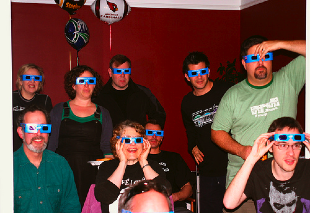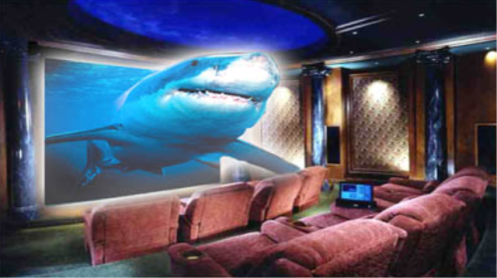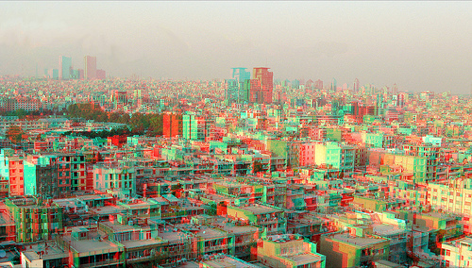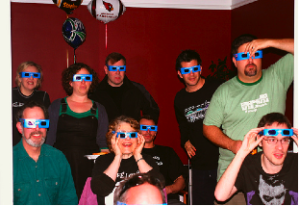
3D technology is here to stay. But for how long? Credit: digitalproductionme.com
3D technology has come a long way. Starting as little more than a way of view photographs, 3D film became a short-lived fad in the 1950’s before dropping into the realm of gimmickry. Thanks to the development of IMAX and newer, more manageable equipment though, the medium has made a huge comeback.
3D television for the home is less than a year away, and the use of 3D technology in the record-breaking movie “Avatar” has likely ensured that the medium is here to stay.
But beyond that, does anyone really know how far 3D film and television can go? There are theories, but its impossible to know for certain what role 3D technology will play 10 years from now. I’ll be reviewing the history of inner workings of 3D technology in this blog entry, as well as presenting my own opinion on where I think the medium is headed.
The Past
3D technology first came into being in 1838, when Professor Charles Wheatstone invented the Stereoscope. This device utilized stereoscopic technology, which takes advantage of the fact that humans perceive 2 images in their brain, to allow people to view photographs in 3 dimensions. The device attained a good bit of popularity after its introduction, but interest in the Stereoscope waned in the beginning of the 20th century.
Stereoscopic technology re-emerged in 1946, and the 1950’s 3D fad took off not long after. Films such as “House of Wax” and Alfred Hitchcock’s “Dial M for Murder” were shot using stereo cameras and shown using the anaglyph method, thus requiring viewers to wear those all-too-familiar red and blue glasses. Like the stereoscope, this method plays off of the fact that humans perceive 2 different images in their brain. Thus, 3D films were shot using 2 cameras placed near each other (this later became one camera with the ability to shoot 2 different images). The glasses then forced viewers to see a red image in one eye and a blue one in the other.
This method also came with its fair share of problems. The cameras used to shot the film were unwieldy, and they could only be shown using limited colors and detail, thanks to the colored glasses. Naturally, the 3D fad died out just a few years after it began.

Polarizing glasses work similarly to the older red and blue ones, but are not dependent on color. credit: Howstuffworks.com
Today’s 3D
3D technology didn’t really re-emerge until the introduction of IMAX 3D in the 90’s, along with the RealD cinema and Dolby 3D screening systems, which both manipulate polarized light in order to show 3D films. A few feature films were shown in 3D in the first half of the 21st century, but only in the past few years has the medium really taken off. Animated films in particular have made frequent use of 3D, and the few live-action films to utilize 3D have meet with varying amounts of success.

Sony is one of the leaders of the 3D revolution.
Until recently, 3D television has been utilized very infrequently. 3D TV is really just getting off the ground this year, with the onset of 3D channels in Britain and Japan and certain events being shown in 3D in the U.S. The 3D televisions being introduced by Samsung, Sony and other companies use their own method of 3D screening, which require viewers to wear shutter glasses (though methods that don’t require glasses are being researched).
The Future Refocused
The 3D medium undeniably has a bright future ahead of it. But how bright of a future is it? Most of the talk for now centers around 3D TV. Companies like Sony are prepared to put 3D TVs out on the market, and several 3D television channels are in the works (and some outside the U.S. are already going). Despite this, it will probably be a long time before 3D TVs become commonplace, mostly due to cost and other economic reasons.

Is Cameron's other record-breaking movie worth watching in 3D?
As for film, the number of movies offered in 3D is increasing. Studios are slowly realizing the money making potential of the medium, and there’s also the fact that they are harder to pirate than 2D films. James Cameron, the director of “Avatar”, is in the process of converting many of his previous films into 3D, including “Titanic” and “Terminator 2”. There is, however, a bit of criticism surrounding most live-action 3D films, stemming from the fact that most films are filmed in 2D and then modified to be shown in 3D. Journalists from The Observer expand on this issue (see the video at the end of this post), saying that films that are transferred to 3D after the fact often come a across as gimmiky. Basically, the film has to be made for the 3D medium, like “Avatar” was. This likely won’t be a problem as 3D continues to grow: more movies will be made with 3D in mind in the direct future. As far as film is concerned, 3D is already a large force. 3D films may end up overshadowing 2D within a few years or so, but it certainly won’t do away with them.
This leads me to my main question about the future of 3D. There’s a double standard when it comes to 3D content. Drama films, for example, don’t have much need for 3D, so they will continue to be shown in 2D. The big film companies though, will likely end up favoring the 3D format. The money making possibilities of 3D have already been proven, but it also makes movies much harder to pirate, since you can’t really record 3D film illegally. This question will likely have a large impact on 3D television as well, since most drama and comedy shows have no use for 3D. Despite the vast potential of 3D TV, I think that the majority of television will only be shown in 2D for quite a while due to this double standard. Can the 2D and 3D mediums co-exist? I believe that they can, but at this point, it’s hard to tell.
I think that it will be quite a while before 3D TV has a significant impact on the television industry, simply due to economic reasons and the abundance of programming that has no use for 3D. But seeing the recent financial success of 3D movies, 3D film may become dominant within the next 10 years. There are plenty of people who are willing to pay extra to see 3D films, and I think the movie industry will pick up on this. As far as this medium is concerned, the future is now.
Sources: http://blog.mission3-dgroup.com/2009/01/22/the-history-of-3d-photography/
http://www.variety.com/article/VR1118008671.html?categoryid=1009&cs=1
http://www.azcentral.com/thingstodo/movies/articles/2009/03/26/20090326danimation0326.html
http://www.popsci.com/gadgets/article/2010-01/its-about-time-3-d-comes-home
http://www.wired.com/gadgetlab/2009/10/3d-tv-explainer/
http://news.bbc.co.uk/2/hi/technology/8285187.stm
http://www.sony.net/SonyInfo/News/Press/200910/09-117E/
http://science.howstuffworks.com/3-d-glasses2.htm
Wikipedia:
http://en.wikipedia.org/wiki/3D_television








